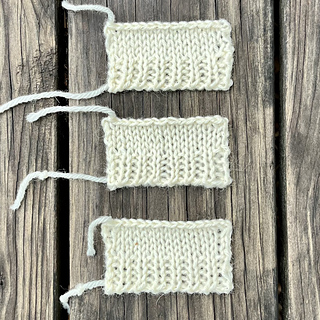KAL info link
The Unraveling…A Knitting Podcast will host a KAL (start date: 1/18/25) that explores the exercises in Patty Lyons’ Knitting Bag of Tricks: The Official Workbook. This workbook, along with Lyons’ original Knitting Bag of Tricks, covers tips and tricks to improve many aspects of one’s knitting.
Yarn usage:
- Lesson 1: 15g Wool of the Andes (mink heather)
- Lesson 2: 24g cloud Wool of the Andes (cloud)
- Lesson 3: 22g Sugar ‘n Cream (jute), 20g Caron Cakes (Cake Pop); 16g Cascasde 220 Superwash Merino (West Point blue)
- Lesson 4: 1g Wool of the Andes cloud, 2g artic, 3g haze heather, 10g starling heather (several attempts with this swatch)
Lesson notes:
-
Lesson 1 - I switched to combination knitting 1.5 years ago and have not knit much flat work since the change. I was surprised to see how uneven my stockinette and ribbing were. I worked 16 rows of ribbing; k1, p1 combination style on the bottom and k1, Norwegian p1 on top. The Norwegian purls made ribbing smoother. I thought my purls were the issue but found out differently in lesson 2.
-
Lesson 2 -Bottom section used US 7 needles and combination knitting. My gauge was larger than the ball band recommendation, so I went down a needle size. Second from bottom section used US 6 needles and combination knitting, while working “your measuring cup exercise.” This revealed I was working off needle tips. Third section from bottom used US 6 needles and Western knitting, while working “the space between stitches” exercise. This made me realize I had been scooping the yarn forward out of the stitch with my needle tip instead of exiting the stitch following the angle of the left needle. The top section was my favorite. I had never lazy swatched in-the-round this way before and the edges were more stable. After blocking, my 3rd from the bottom section (flat stockinette, Western style) had the same gauge as the top in-the-round section.
-
Lesson 3 -swatch #3: Used Cascade 220 superwash merino, worsted-weight, US7 needles, 29 stitches, 26 rows of stockinet, 3 repeats of basket weave pattern. -swatch #4: Used Caron Cakes 80% acrylic, 20% wool worsted-weight, US7 needles, 29 stitches, 33 rows stockinette, 4 repeats of basket weave pattern. -swatch #5: Used Sugar ‘n Cream 100% cotton, worsted-weight, 29 stitches, 26 rows of stockinette, 3 repeats of basket weave pattern. Comparison:None of these yarns stretched after being weighted. Swatch 3 (superwash merino) was the softest and most elastic. Swatch 5 (cotton) was the heaviest, least stretchy, and largest swatch.
-
Lesson 4: Swatch #6/long tail CO (top), swatch #7/long tail CO in pattern (2nd from top), swatch #8/cable cast-on in purl (2nd from bottom), swatch #9/cable cast-on in pattern (bottom). I loved learning how to square my CO ends and how to CO in pattern for long tail and cable COs. I need to continue to determine why my alternating cable CO is leaning to the right.
-
Cable cast-on in pattern experiment: Marta and I discussed how many of the cable cast-on in pattern swatches we viewed slightly leaned to the right. She mentioned most of the leaning disappeared after giving the swatch a good tug/stretch. Then Marta wondered what would happen if you performed the YO trick more than once to square the end of the CO. So I made three swatches. The top swatch was made according to the workbook’s cable cast-on in pattern directions (adding the YO trick to the last stitch one time). The middle swatch was made by adding the YO trick to the second to the last and the last stitches. The bottom swatch was made by adding the YO trick twice to the last stitch. All swatches were firmly (but not aggressively) blocked. (Does that make them passive aggressive?)
-
Lesson 5: Basic at first, then went into making increases and decreases tidier. I especially liked learning when and where to use backwards YOs to make lace patterns symmetrical.
-
Lesson 6: Best tip learned was the jogless single round stripe in swatch #10. Most aggravating occurrence was the perfect neck exercise in swatch #7. The instructions left me hanging in the middle of the neck on p. 98, then resumed from the edge of the work on p.99. I told Patty Lyons on her educational website that I was struggling how to understand what was going on between the pages; I was referred to her online sweater class. Later, she released an errata list for this workbook and instructions were added to p. 98 explaining how to get from the center of the neck to the edge of the work to be ready for the instruction’s continuation on p.99.
-
Lesson 7: Lesson 7: swatch 6 (top left), swatch 11 (top right), seamed swatches 7&8 (bottom). Diagrams in pages 180-182 of the original Knitting Bag of Tricks have errata.
 FrettyBetty >
FrettyBetty >  notebook > projects > Unraveling Bag Of Tricks KAL
notebook > projects > Unraveling Bag Of Tricks KAL 












162069 projects
stashed
89484 times
103947 projects
stashed
79002 times
13703 projects
stashed
9885 times
27074 projects
stashed
14761 times


 handspun
handspun queue
queue favorites
favorites friends
friends needles & hooks
needles & hooks library
library